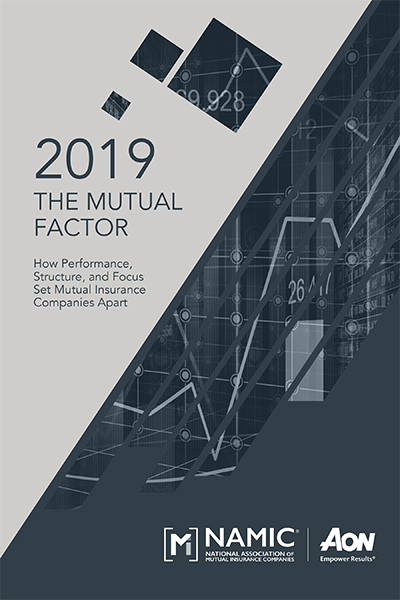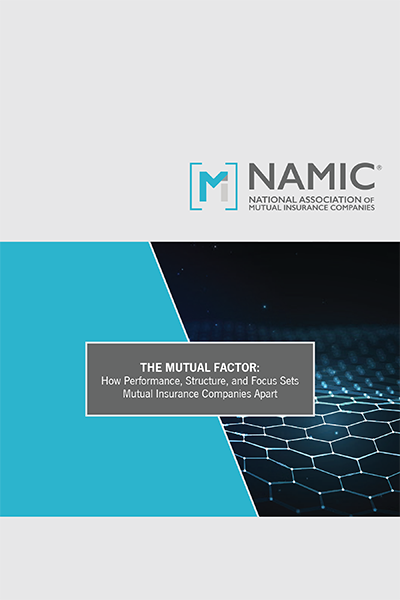The 2024 Mutual Factor
Now in its seventh iteration, NAMIC’s 2024 Mutual Factor report follows the release of the second midyear report issued in late June, which previewed the high-level U.S. insurance company financials emanating from 2023 and the start of 2024. NAMIC and Aon appreciate the continued interest in this report, with the 2024 report providing a unique perspective on the impact that the past 24-30 months have had on our industry.
As the industry continues to navigate the challenging circumstances brought on by the clashing impact of inflation, weather, and legal system abuse, mutual insurers have remained steadfast in their commitment to their policyholders and the long-term stability they are known for. However, the perpetuation of the new era of risk has required swift underwriting action, active engagement with regulators, clear communication to agency partners, and short-, medium- and long-term strategic decision-making aimed at returning the industry to the position of steady profitability needed to allow mutual insurers to continue to meet the growing needs of their customers and agency partners.
Among the key findings on financial performance:
-
In 2023, mutual insurers recorded loss and loss adjustment expenses of 84.0 percent of premium compared to the five-year average of 77.3 percent. Stock companies outperformed their mutual counterparts at 71.1 percent for 2023, which compares more closely to their five-year average of 70.8 percent.
-
In 2023, the industry grew capital and surplus by 6.1 percent, a considerable shift from the 6.5 percent decrease in capital in 2022.
-
The combined ratio for mutual insurers for Q2 2024 was 103.6, compared to 113.7 during the same period in 2023. Stock insurers saw combined ratios of 94.3 in Q2 2024 versus 100 in Q2 of 2023, reflecting their focus on returns.
The Mutual Factor 2024 concludes with a consumer opinion survey about the property/casualty industry conducted by research firms Readex Research and Dynata, following a similar benchmark study by a separate firm in 2018. Key findings include:
-
Of respondents familiar with mutual insurance companies, eighty-eight percent said they were at least somewhat likely to choose a mutual insurance company for their next auto or home insurance purchase.
-
Twenty-eight percent made a change in insurance company recently. Of those who made changes, 65 percent reported it being due to price of premium.
As the industry continues to steadily navigate the challenging environment, NAMIC and Aon continue to share an enthusiasm for the publishing and evolution of this report.
Get Your Copy Of The 2024 Mutual Factor Report
Sponsored by:

THE MUTUAL FACTOR – A 2024 MIDYEAR UPDATE
Each year since its launch in 2018 NAMIC has unveiled the latest in an ongoing series of reports known as The Mutual Factor. The reports, developed by NAMIC in partnership with Aon, provide an updated look at multiple performance metrics illustrating how the mutual insurance industry is doing in relation to other non-mutual insurance companies. The reports also periodically feature an opinion survey of key stakeholders regarding their view of mutuals compared to non-mutuals.
In this year’s Mutual Factor Midyear Update, now in its second year of publication, NAMIC and Aon provide members the opportunity to reflect on the close of the prior year, the challenges that remain for our industry, perspectives shared by the world’s leading reinsurers, and opportunities that lie ahead for mutual insurers. Specifically, the 2024 Midyear Report provides perspective on the impact of significant events on the mutual industry that occurred between September 2023 and April 2024, U.S. catastrophe and secondary peril losses, inflation, legal system abuse, and the state of the reinsurance market.
Key takeaways include:
-
Highlighting another active year for weather in the U.S., in 2023, natural disasters resulted in economic losses estimated at $114 billion, slightly above the long-term mean ($105 billion) and notably above the median since 2000 ($84 billion). 2023 was the costliest year in U.S. history for Severe Convective Storms, which contributed an astonishing $73 billion of the total economic loss and generated nearly $59 billion of total insured loss.
-
With heightened wildfire activity in Texas and Oklahoma in February and March, Q1 2024 experienced the highest U.S. insured loss total from wildfires on record. Nearly all of these losses came from the Smokehouse Creek Fire in Texas and western Oklahoma.
-
Given the challenges that the homeowners line of business has presented NAMIC’s membership over recent years, the cooling of inflation is a helpful factor to foster broader market stabilization.
-
Through a combination of retained earnings, investment returns, and new capital funding, global reinsurance capital has quickly rebounded across both the traditional and alternative capital spaces. This has fundamentally helped stabilize the reinsurance marketplace in the early months of 2024.
Work is underway on the 2024 Mutual Factor Report with NAMIC and Aon continuing to partner in delivering expanded insights into the overall performance of the mutual insurer segment. The full 2024 Mutual Factor report will be published in September to coincide with NAMIC’s annual convention.
Get Your Copy Of The 2024 Mutual Factor Midyear Report
Sponsored by:

THE 2023 MUTUAL FACTOR
During the association’s 128th annual convention, NAMIC released its annual report on the state of the mutual insurance industry. The 2023 Mutual Factor, produced in partnership with Aon, provides an updated look at more than 30 different performance metrics designed to illustrate how the mutual segment is doing in relation to other non-mutual companies.
The 2023 Mutual Factor report provides a sobering look at a challenging period from the start of 2022 through the first part of the current year. During this time frame, the mutual insurance industry faced increasing pressures from weather and reinsurance factors, yet it has remained focused on its policyholders. The last report highlights the strong capital position of the mutual segment, despite external challenges, once again demonstrating the industry’s continued commitment to strengthen balance sheets to support policyholders and the broader economy.
Specific highlights include:
-
The mutual sector ended 2022 with an increase in losses and loss adjustment expense; the growth in net earned premium did not offset these losses that resulted in a higher loss and LAE ratio (76.4%) compared to 2021 (72.5%) for the industry.
-
In 2022, the industry lost capital and surplus, a 6.4% decrease from the record high of $1.053 trillion in 2021. Mutual insurers shrank by 8%, while stock companies lost 5.4%. The loss in surplus was mainly attributed to challenging underwriting results and investment volatility. On a five-year basis, the industry has grown surplus with mutuals’ five-year compound average growth rate 8.5% and stocks companies’ five-year surplus growth rate 11.4%.
-
The decline in capital and surplus have led to higher premium leverage industrywide thereby decreasing the amount of capital standing behind each dollar of premium written. Mutual and stock insurers held $1.26 in policyholder surplus backing up each dollar in net premiums written through 2022.
-
Mutual companies are well capitalized with median Best’s Capital Adequacy Ratio at the VaR 99.6 of 58%, 7 percentage points higher than stock companies at 51%. Eighty-nine percent of mutual companies also have the “Strongest” or “Very Strong” balance sheet strength, compared to 81% for stock companies.
Get Your Copy Of The 2023 Mutual Factor Report
Sponsored by:

The 2022 Mutual Factor – 5 Years Later
The 2022 Mutual Factor report found that the mutual insurance industry ended 2021 with strong performance overall, with a record surplus of more than 13 percent growth. And despite a challenging first six months of 2022, the industry saw a return to some pre-pandemic normalcy. The annual update evaluated nearly 30 performance metrics for mutual insurance companies in 2021 compared to other insurer categories and assessed the impact of rating agency criteria on mutuals.
Among the key findings on financial performance:
-
In Q2 2022, the policyholder dividend ratio for mutual insurers was normalized to pre-pandemic levels at around 1 percent. Stock insurers dividend ratios remained flat through the pandemic as they returned money to insureds through premium credits.
-
Mutual insurers ran at an underwriting loss as a result of the challenging quarter for the industry. The combined ratio for mutual insurers for Q2 2022 was 113.8 percent compared to 97.0 percent for stock companies, which operated at an underwriting profit, aligning with their focus on returns.
-
In 2021, the industry hit a record $1.053 trillion in capital and surplus, growing 13.3 percent from 2020. Mutual insurers grew by 10.1 percent, while stock companies grew by 15.8 percent. The growth in surplus was mainly attributed to increase in unrealized capital gains and insurer income from the soaring stock market and declining interest rates. Mutuals’ five-year compound average growth of rate 7.4 percent, while stock companies’ five-year surplus growth rate of 9.1 percent, has been bumped up by strong 2021 results.
-
Decreasing and low interest rates remained a challenge for the insurance industry in 2021, with yields on invested assets remaining under 3.0 percent for mutual and stock companies alike, at or close to their lowest levels since the beginning of the financial crisis in 2008. Yields are slightly lower for mutual insurers, suggesting a somewhat more conservative fixed-income portfolio. However, the first half of 2022 saw a stark shift in this trend with rising yields and interest rates.
The 2022 Mutual Factor report conducted a series of in-depth interviews with 24 CEOs and senior executives from leading reinsurance companies in the U.S., Germany, the UK, and Bermuda. Companies ranged in size from small to very large global firms and included both publicly held and mutual companies. Specific highlights include:
-
Most reinsurers believe that extreme weather events are becoming more frequent and more severe. Many of these events (e.g., derechos, wildfires) are unmodeled and the true extent of risk may be unknown. These events have had a negative impact on reinsurers’ earnings in recent years.
-
Economic inflation, while expected to be short-lived, is a key year-end consideration. Social inflation is a looming concern and considered a more insidious problem by reinsurers.
-
Reinsurers see mutuals as a desirable and a stable part of their portfolios. Yet, some very large reinsurers value working with the largest mutual insurers, feeling it is uneconomical to deal with smaller, regional mutual companies.
-
Growth is not a key criterion used by reinsurers in assessing the financial health of mutual insurers. In fact, rapid growth is a red flag, unless there is a solid strategy behind it. In general, reinsurers look at results, ratings agencies, key ratios, and management as the most important factors.
GET YOUR COPY OF THE 2022 REPORT
Find out:
-
How reinsurance industry thought leaders view the challenges facing their industry along with their insights on the value of their relationships with the mutual sector;
-
How the mutual industry performed in the first two quarters of 2022; and
-
Year-over-year data over the last five years and how mutuals compare to other insurers in the industry.
THE 2021 MUTUAL FACTOR
The mutual property/casualty insurance industry remains financially sound despite the uncertainty created by the ongoing COVID-19 pandemic and an increasing number of severe natural disasters. That is the conclusion of the fourth annual market performance analysis released during its 126th annual convention by the National Association of Mutual Insurance Companies and its partner, Aon.
The latest report, “Mutual Factor 2021: How Performance, Structure, and Focus Set Mutual Insurance Companies Apart, evaluated nearly 30 performance metrics for mutual insurance companies in 2020 compared to other insurer categories and assessed the impact of rating agency criteria on mutuals. Similar to last year’s report, the newest Mutual Factor Report analyzed performance metrics for the first two quarters of 2021 and shared findings from a recent survey of independent insurance agents.
Among the key findings from the 2021 Mutual Factor:
-
In response to the challenges faced by policyholders during COVID-19, we estimated that the industry returned nearly $13 billion in premiums throughout 2020, with mutual insurers returning $6.1 billion mainly through policyholder dividends, while stocks returned $6.8 billion primarily through premium credits. In Q2 2021, the policyholder dividend ratio for mutual insurers was normalized to pre-pandemic levels of around 1 percent. Stock insurers dividend ratios remained flat through the pandemic as they returned money to insureds through premium credits.
-
Mutual insurers ran at an underwriting loss as a result of their increased policyholder dividend ratio. The combined ratio for mutual insurers for Q2 2021 was 100.3 percent compared to 95.6 percent for stock companies, which operated at an underwriting profit, aligning with their focus on returns.
-
Mutual companies are well capitalized with median Best’s Capital Adequacy Ratio at the VaR 99.6 of 61 percent, 9 points higher than stock companies at 62 percent. Eighty-nine percent of mutual companies also have the “Strongest” or “Very Strong” balance sheet strength compared to 81 percent for stock companies.
The 2021 Mutual Factor Report surveyed 200 independent insurance agents from across the country to assess their perceptions of mutual insurers in comparison to stock and other types of insurance companies. Specific highlights include:
-
Mutual companies are perceived as delivering better than other companies on six key criteria used by agents to select insurance companies. Among the criteria in the top tier of importance, mutual companies were rated higher on two key metrics: excellent communications with agents and always settle claims fairly.
-
The more favorable perceptions of mutuals among agents translates into positive business for mutual insurance companies, with the share of agents’ business among mutuals at 55 percent compared to 45 percent for stock companies.
GET YOUR COPY OF THE 2021 REPORT
Find out:
-
How independent insurance agents view mutual companies in comparison to stocks and what challenges agents see for the future.
-
How the industry performed in the first two quarters in 2021 amid the ongoing pandemic
-
Year-over-year data and how mutuals compare to others in the industry.
The 2020 Mutual Factor
The mutual property/casualty insurance industry remains financially sound despite the tumultuous first half of 2020 and is well positioned for the future. That is the conclusion of the third annual market performance analysis released during the 125th convention by the National Association of Mutual Insurance Companies and its partner, Aon.
The latest report, “Mutual Factor 2020: How Performance, Structure, and Focus Set Mutual Insurance Companies Apart,” evaluated nearly 30 performance metrics for mutual insurance companies in 2019 compared to other insurer categories and assessed the impact of ratings agency criteria on mutuals. The 2020 report goes a step further, however, in recognition of the unparalleled circumstances facing the insurance industry as the result of the COVID-19 pandemic. The 2020 Mutual Factor report also analyzed performance metrics for the first two quarters of 2020 and looked at how thought leaders perceive the mutual industry.
Among the key findings from the 2020 Mutual Factor:
-
In response to the challenges faced by policyholders during COVID-19, the report estimated that the industry returned nearly $9 billion in premiums in Q2 2020, with mutual insurers returning $4.5 billion mainly through policyholder dividends, while stocks returned $4.3 billion primarily through premium credits.
-
In Q2 2020, policyholder dividend ratio for mutual insurers was 5.8 percent compared to 1.1 percent in Q1 2020, while the policyholder dividend ratio for stock insurers remained below 1.0 percent for both quarters
-
Mutual companies are well capitalized with median Best’s Capital Adequacy Ratio at the VaR 99.6 of 59 percent, 10 points higher than stock companies at 49 percent. Ninety percent of mutual companies also have the “Strongest” or “Very Strong” balance sheet strength, compared to 79 percent for stock companies.
In a survey of 22 industry executives across different sizes and lines of business, the 2020 Mutual Factor report sought to gain perspective on what challenges the industry currently faces and will face in the future. Specific highlights include:
-
Many executives agreed that the pandemic served as a catalyst and accelerated the pace of technological change. As a result, many predict that digitization and advanced technology may lead to consolidations of smaller companies.
-
The executives highlighted the benefits of being a mutual insurer and the commitment mutual insurers place on impacting their communities and to diversity.
GET YOUR COPY OF THE 2020 REPORT
Find out:
-
What leaders in the industry see as the challenges and opportunities that lie ahead.
-
How the industry performed in the first two quarters in 2020 amid the pandemic
-
Year-over-year data and how mutuals compare to others in the industry.
THE 2019 MUTUAL FACTOR
Released during NAMIC’s 124th Annual Convention, the new expanded edition of the Mutual Factor includes a comparison of nearly 30 metrics across mutual, stock, and other categories. And just as the first report did last year, this new analysis adds further evidence to support the overall strength and stability of mutual companies. The 2019 report, developed jointly by NAMIC and Aon, not only looks at key market performance metrics for mutuals, but also at how mutuals are rated under the AM Best Credit Rating Methodology Framework.
The 2019 Mutual Factor broadens the scope of the data analyzed from 16 metrics in 2018 to 28 metrics in 2019. And, thanks to the involvement of Aon, the new Mutual Factor also takes a comprehensive look at the performance of more than 600 insurers under the BCRM framework. The bottom line is – like last year’s report – mutuals remain consistently strong, with more data to substantiate that statement.
The key findings in the Mutual Factor include:
-
Mutual insurers were slightly less leveraged than their stock counterparts in 2018, with $1.23 in policyholder surplus backing up each dollar in net premiums written compared to $1.20 for stock insurers.
-
In 2018, the dividend ratio, a gauge of the proportion of premium returned to policyholders, was five times larger for mutuals than for stock companies.
-
Capital and surplus in the mutual segment grew by 1.8 percent in 2018, an improvement in comparison to stock companies that saw surplus growth decline by more than 3 percent due to higher underwriting costs.
-
Mutual companies are well capitalized with median Best’s Capital Adequacy Ratio at the VaR 99.6 of 59 percent, 10 points higher than stock companies at 49 percent. Ninety percent of mutual companies also have the “Strongest” or “Very Strong” balance sheet strength, compared to 78 percent for stock companies.
GET YOUR COPY OF THE 2019 REPORT
Find out:
-
How mutuals compare to other in the property/casualty insurance industry
-
How mutuals stack up against AM Best ratings
-
What commercial insurance customers think about mutuals
THE 2018 MUTUAL FACTOR
The 2018 Mutual Factor was developed jointly by NAMIC and Robert Hartwig, Ph.D., director of the Center for Risk and Uncertainty Management at the University of South Carolina. The analysis evaluated 16 different performance metrics for 2017, comparing mutuals, stock companies, and other insurers.
Among the key findings of the study were:
-
Mutual insurers were less leveraged than their stock counterparts in 2017, with $1.89 in policyholder surplus backing up each dollar in net premiums written, compared to $1.64 for other insurers.
-
The dividend ratio, a gauge of the proportion of premium returned to policyholders, was eight times larger for mutuals.
-
Mutual companies are more likely to temper the pace of rate increases, resulting in greater price stability, because they are not as driven by the need for short-term profitability.
-
Capital and surplus in the mutual segment grew by more than 8 percent in 2017 – very strong by historical standards and despite heavy CAT losses.
GET YOUR COPY OF THE 2018 REPORT











